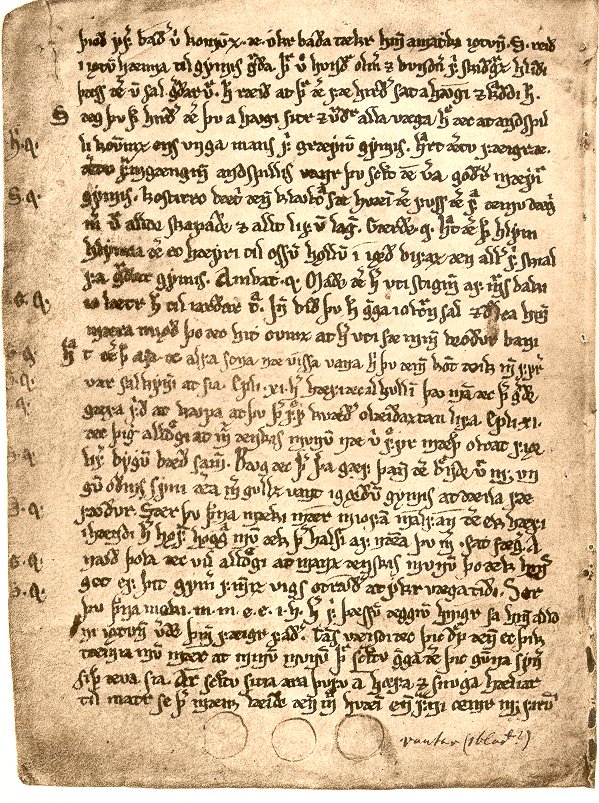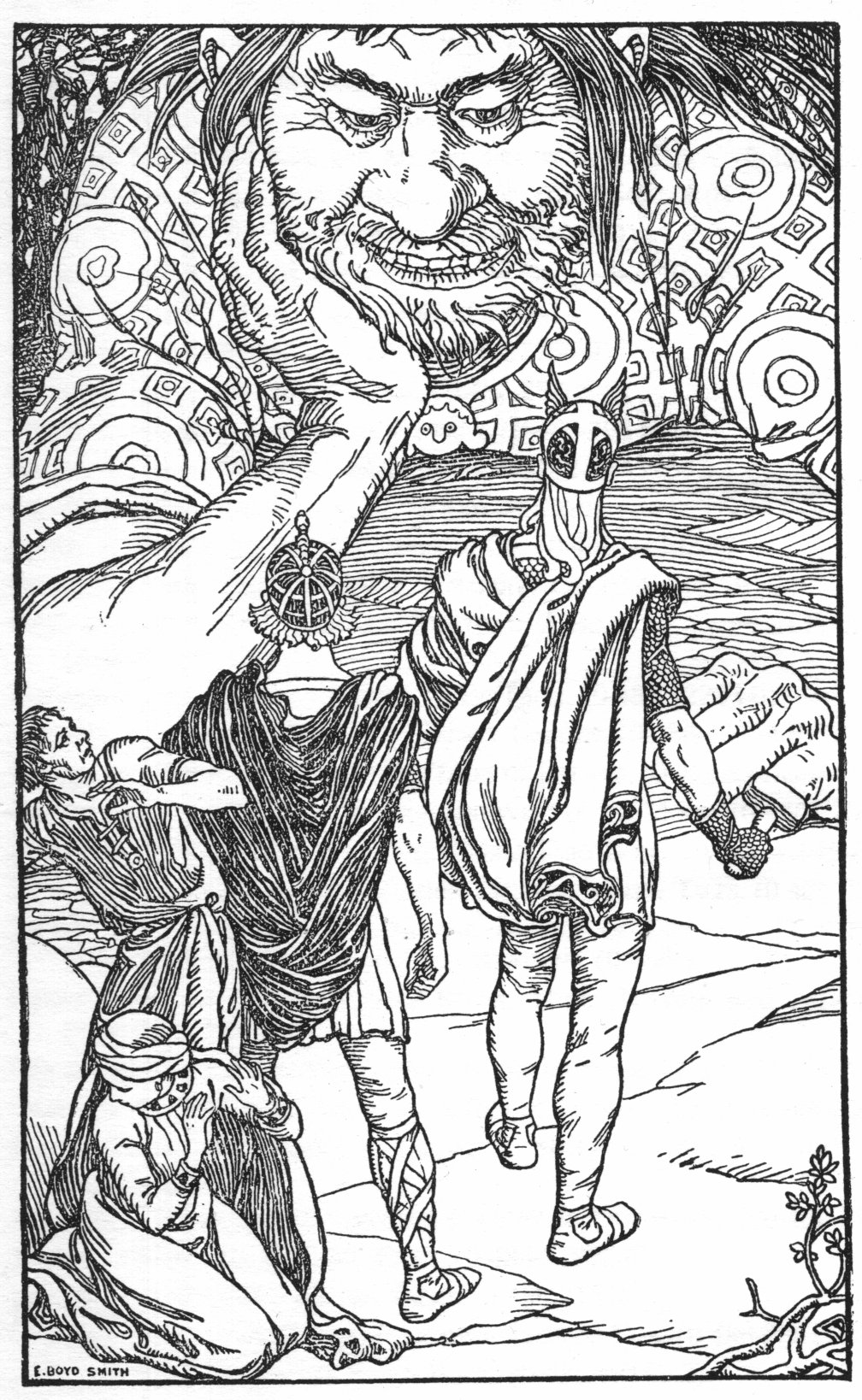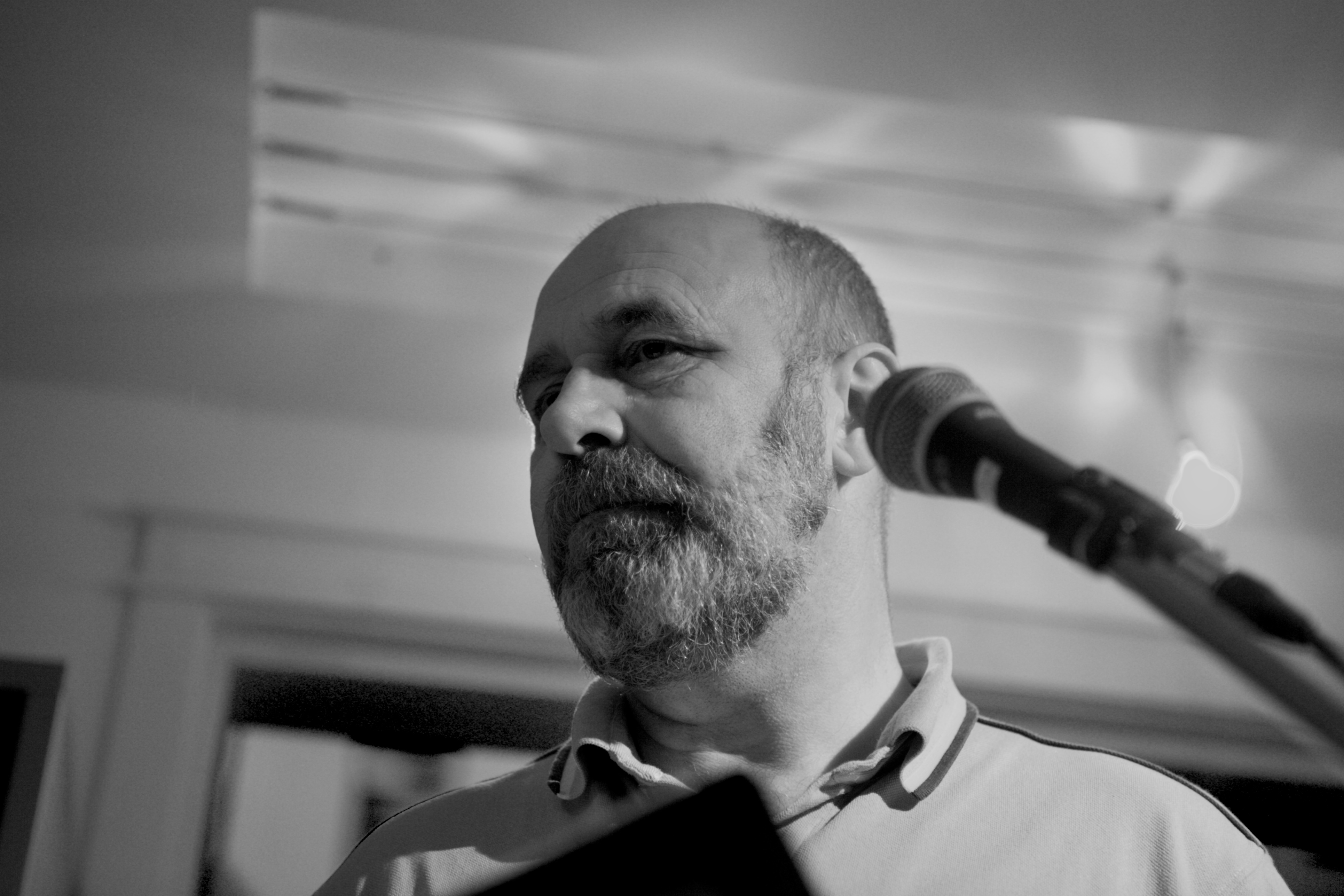|
Rímur
In Icelandic literature, a ''ríma'' (, literally "a rhyme", pl. ''rímur'', ) is an epic poem written in any of the so-called ''rímnahættir'' (, "rímur meters"). They are rhymed, they alliterate and consist of two to four lines per stanza. The plural, ''rímur'', is either used as an ordinary plural, denoting any two or more rímur, but is also used for more expansive works, containing more than one ríma as a whole. Thus '' Ólafs ríma Haraldssonar'' denotes an epic about Ólafr Haraldsson in one ríma, while '' Núma rímur'' are a multi-part epic on Numa Pompilius. Form ''Rímur'', as the name suggests, rhyme, but like older Germanic alliterative verse, they also contain structural alliteration. ''Rímur'' are stanzaic, and stanzas normally have four lines. There are hundreds of ''ríma'' meters: Sveinbjörn Beinteinsson counts 450 variations in his ''Háttatal''. But they can be grouped in approximately ten ''families''. The most common metre is ''ferskeytt''.Véstein ... [...More Info...] [...Related Items...] OR: [Wikipedia] [Google] [Baidu] |
Skáld-Helga Rímur
''Skáld-Helga rímur'' ('the ''rímur'' of Poet-Helgi', also ''Skáldhelga rímur'' or ''Skáldhelgarímur'') is an Icelandic ''rímur''-poem from the 1400s. The poem comprises seven ''rímur'', based on a now lost ''Íslendingasaga'', ''Skáld-Helga saga'', set around the first half of the eleventh century. Each ''ríma'' begins with a ''mansöngr''. The main character is the poet Helgi Þórðarson, portrayed as a retained of Erik Håkonsson and Olaf the Holy. Later he travels to Rome and meets the Pope, before proceeding to Greenland, where he ends his days as a law-man at Brattahlíð. The main theme of the ''rímur'' is the passionate love between Helgi and his betrothed, Þórkatla, from whom he is separated by fate and by human wickedness. The stephes, which are based on variants of the metre ''ferskeytt'', are often very sentimental. From the fourth ''ríma'' onwards, when Helgi goes to Greenland, there are also lurid supernatural elements: Helgi's boat is boarded by a wa ... [...More Info...] [...Related Items...] OR: [Wikipedia] [Google] [Baidu] |
Mansöngr
A ''mansǫngr'' (literally 'maiden-song'; plural ''mansǫngvar''; modern Icelandic ''mansöngur'', plural ''mansöngvar'') is a form of Norse poetry. In scholarly usage the term has often been applied to medieval skaldic love-poetry; and it is used of lyric openings to ''rímur'' throughout the Icelandic literary tradition. In high-medieval Iceland Skaldic love-poetry and erotic poems in Old Norse-Icelandic are often characterised in modern scholarship as ''mansöngvar''. However, Edith Marold and Bjarni Einarsson have argued that the term ''mansöngr'' has been over-used in medieval scholarship, being applied to love-poems which we have no evidence were actually viewed as ''mansöngvar''. Many medieval references to ''mansöngvar'' are not accompanied by the poem in question, and the boundaries of the genre are thus disputed. The Icelandic Homily Book (from c. 1200) mentions ''mansöngr'' in connection with the music of David and Solomon. In Icelandic sagas In ''Egils saga'', ... [...More Info...] [...Related Items...] OR: [Wikipedia] [Google] [Baidu] |
Sveinbjörn Beinteinsson
Sveinbjörn Beinteinsson (4 July 1924 – 23 December 1993) was an Icelandic religious leader and singer of rímur who was instrumental in helping to gain Icelandic government's recognition of the pre-Christian Heathenry in the country. Biography Sveinbjörn lived his entire life in West Iceland Borgarfjörður. From 1944 on, he was a sheep farmer while also pursuing literary interests on the side. He published a book of rímur in 1945, a textbook on the verse forms of rímur in 1953, two volumes of his own verse in 1957 and 1976, and edited several anthologies. He was married to Svanfríður Hagvaag with whom he had two sons, born in 1965 and 1966. The Ásatrúarfélagið ("Fellowship of Æsir faith"), which he co-founded in 1972, and for which he acted as '' allsherjargoði'', was officially recognised as a religious body in 1973. Sveinbjörn is regarded with much respect and affection amongst Germanic neopagans. Not only was he a well known rímur singer, or ''kvæðam ... [...More Info...] [...Related Items...] OR: [Wikipedia] [Google] [Baidu] |
Icelandic Literature
Icelandic literature refers to literature written in Iceland or by Icelandic people. It is best known for the sagas written in medieval times, starting in the 13th century. As Icelandic and Old Norse are almost the same, and because Icelandic works constitute most of Old Norse literature, Old Norse literature is often wrongly considered a subset of Icelandic literature. However, works by Norwegians are present in the standard reader ''Sýnisbók íslenzkra bókmennta til miðrar átjándu aldar'', compiled by Sigurður Nordal on the grounds that the language was the same. Early Icelandic literature The medieval Icelandic literature is usually divided into three parts: *Eddic poetry *Sagas *Skaldic poetry The ''Eddas'' There has been some discussion on the probable etymology of the term "Edda". Most say it stems from the Old Norse term ''edda'', which means great-grandmother, but some see a reference to Oddi, a place where Snorri Sturluson Snorri Sturluson ( ; ; 1179 – 22 S ... [...More Info...] [...Related Items...] OR: [Wikipedia] [Google] [Baidu] |
Alliterative Verse
In prosody, alliterative verse is a form of verse that uses alliteration as the principal ornamental device to help indicate the underlying metrical structure, as opposed to other devices such as rhyme. The most commonly studied traditions of alliterative verse are those found in the oldest literature of the Germanic languages, where scholars use the term 'alliterative poetry' rather broadly to indicate a tradition which not only shares alliteration as its primary ornament but also certain metrical characteristics. The Old English epic ''Beowulf'', as well as most other Old English poetry, the Old High German ''Muspilli'', the Old Saxon ''Heliand'', the Old Norse ''Poetic Edda'', and many Middle English poems such as ''Piers Plowman'', ''Sir Gawain and the Green Knight'', and the '' Alliterative Morte Arthur'' all use alliterative verse. While alliteration can be found in many poetic traditions, it is 'relatively infrequent' as a structured characteristic of poetic form.Frog, ... [...More Info...] [...Related Items...] OR: [Wikipedia] [Google] [Baidu] |
Sigurður Breiðfjörð
Sigurður Breiðfjörð (4 March 1798 – 1846) was an Icelandic poet. He learned cooperage for four years in Copenhagen and worked as a cooper in Iceland and Greenland. He was a prolific and popular traditional poet, known for his ''rímur In Icelandic literature, a ''ríma'' (, literally "a rhyme", pl. ''rímur'', ) is an epic poem written in any of the so-called ''rímnahættir'' (, "rímur meters"). They are rhymed, they alliterate and consist of two to four lines per stanza. T ...'' cycles. ''Núma rímur'' is his best-known work. References * Neijmann, Daisy L. (1996). ''The Icelandic Voice in Canadian Letters : The Contribution of Icelandic-Canadian Writers to Canadian Literature.'' McGill-Queen's Press. Sigurður Breiðfjörð Sigurdur Breidfjord 1798 births 1846 deaths Sigurdur Breidfjord Sigurdur Breidfjord {{Iceland-poet-stub ... [...More Info...] [...Related Items...] OR: [Wikipedia] [Google] [Baidu] |
Lokrur
''Lokrur'' is an Icelandic mythological ''rímur'' cycle dated to . It narrates the journey of the god Thor to Útgarða-Loki, a myth also preserved in Snorri Sturluson's 13th century ''Prose Edda'' part ''Gylfaginning''. Compared with the version in ''Gylfaginning'', the ''Lokrur'' version is often more detailed, with fleshed-out descriptions where ''Gylfaginning'' has an understated and terse text. The cycle consists of four ''rímur'', the first in {{lang, is, stafhent and the rest in ''ferskeytt'' meter. The ''rímur'' are preserved in only one medieval manuscript, '' Staðarhólsbók''. Synopsis First ríma The first verse of the first ''ríma'' addresses a woman and asks her to listen to the tale. The ''ríma'' then introduces the gods Odin, Thor and Loki (verses 2-5). The story starts with Thor asking Loki for his aid in meeting his namesake Útgarða-Loki (v. 6-7). Loki is reluctant, warning Thor that Útgarða-Loki is a fearsome troll (v. 8). Thor tells Loki that he ... [...More Info...] [...Related Items...] OR: [Wikipedia] [Google] [Baidu] |
Bólu-Hjálmar
Hjálmar Jónsson (29 September 1796 – 25 July 1875), better known as Bólu-Hjálmar (after his homestead in ''Bóla''), was a 19th-century Icelandic farmer and poet, known for his sharp style and biting wit and for his mastery of the short Icelandic poetic narrative style known as Rímur. Hjálmar was born in Hallandi in Eyjafjörður. His parents, Marsibil Semingsdóttir and Jón Benediktsson, were poor and unmarried, and he spent the first eight years of his life at the farm of Dálksstaðir, where he was raised by the widow Sigríður Jónsdóttir. He had little formal education, but he soon became an avid reader of the sagas and eddas. Hjálmar married Guðný Ólafsdóttir, and the pair began farming at Bakki in Öxnadalur. In 1829, they moved to Bóla (''Bólstaðargerði'') in Skagafjörður, from whence his nickname ''Bólu-Hjálmar'' was derived. The family had difficulty making ends meet, and Hjálmar was constantly engaged in disputes with his neighbours, who accuse ... [...More Info...] [...Related Items...] OR: [Wikipedia] [Google] [Baidu] |
Rímur (album)
''Rímur'' is a limited EP record released independently by Sigur Rós featuring Steindór Andersen performing ''rímur''. It was sold during the band's spring 2001 tour. Only 1000 copies of the EP were printed. A live performance of "Á ferð til Breiðafjarðar vorið 1922" with Steindór later appeared on the band's 2007 DVD release ''Heima ''Heima'' (; ''at home'') is a documentary film and double DVD set about the tour around Iceland in the summer of 2006 of the band Sigur Rós. During the tour the band played two big open-air concerts at Miklatún - Reykjavík (30 July) and Ásby ...''. Track listing References 2001 EPs Sigur Rós albums {{2000s-post-rock-album-stub ... [...More Info...] [...Related Items...] OR: [Wikipedia] [Google] [Baidu] |
Sigur Rós
Sigur Rós () is an Icelandic post-rock band from Reykjavík, active since 1994. The band comprises singer and guitarist Jón Þór "Jónsi" Birgisson, bassist Georg Hólm, and keyboardist Kjartan Sveinsson. Known for their ethereal sound, frontman Jónsi's falsetto vocals, and their use of bowed guitar, Sigur Rós incorporate classical and minimal aesthetic elements. Jónsi's vocals are sung in Icelandic and non-linguistic vocalisations the band have termed ''Vonlenska''. They have released seven studio albums and five EPs since their formation. History 1997–1998: ''Von'' and ''Von brigði'' Jón Þór "Jónsi" Birgisson (guitar and vocals), Georg Hólm (bass) and Ágúst Ævar Gunnarsson (drums) formed the group in Reykjavík in January 1994. The band's name means Victory Rose. They took their name from Jónsi's younger sister Sigurrós, who was born a few days before the band was formed. They soon signed a record deal with the local Sugarcubes-owned record label Ba ... [...More Info...] [...Related Items...] OR: [Wikipedia] [Google] [Baidu] |
Steindór Andersen
Steindór Andersen (born 1954) is an Icelandic musician. Steindór is noted for his Rímur chanting and is most widely known for his collaborations with the band Sigur Rós. Other collaborations include with Hilmar Örn Hilmarsson and rapper Erpur Eyvindarson. Discography * 2001: '' Rímur EP'' (featuring Sigur Rós) * 2002: '' Rímur & Rapp'' (joint with Hilmar Örn Hilmarsson and Erpur Eyvindarson * 2003: ''Rímur'' * 2004: ''Úlfhamsrímur'' * 2013: ''Stafnbúi'' (joint with Hilmar Örn Hilmarsson) ;Appearances After the Folk Music Festival in Siglufjörður, July 2007, where Steindór is a regular guest, another guest musician at the festival, Evan Harlan of the group Andromeda, impressed with Steindór's chanting of the ''rímur'', composed the piece "Steindór Gets the Blues". The music was premiered in Boston, the home of the Icelandic-American group, later the same month. Steindór also appears on Sigur Rós's 2007 DVD release, ''Heima'', performing "Hugann seiða s ... [...More Info...] [...Related Items...] OR: [Wikipedia] [Google] [Baidu] |
Bjarkarímur
''Bjarkarímur'' is a 15th-century Icelandic ''rímur'' cycle on the Skjöldungs (the Scyldings of ''Beowulf''), and retells among other things the adventures of Hróarr (Hroðgar) and his brother Helgi (Halga), and those of Böðvarr Bjarki. It appears to be based on the lost ''Skjöldunga saga'' and is one of the extant sources of information on that work. References * Jónas Kristjánsson, Eddas and Sagas: ''Iceland's Medieval Literature'', trans. by Peter Foote Peter Godfrey Foote (26 May 1924 – 29 September 2009) was a scholar of Old Norse literature and Scandinavian studies. He inaugurated the Department of Scandinavian Studies at University College London, and headed it for 20 years. Early life a ... (Reykjavík: Hið Íslenska bókmenntafélag: 1988), p. 353. {{DEFAULTSORT:Bjarkarimur Old Norse poetry Rímur ... [...More Info...] [...Related Items...] OR: [Wikipedia] [Google] [Baidu] |





.jpg)
